ESSAYS
A Documentary Archive of Prison Experience: Introduction to the PMA
AUTHOR
Cahal McLaughlin
BIOGRAPHY
Director of the PMA and Professor of Film Studies at Queen’s University Belfast
Introduction
In 2004, I filmed three interviews back inside the Maze and Long Kesh prison site, which became Inside Stories. This had been exhibited at Catalyst Arts in 2005 as a three-screen installation (and later, with the addition of another interview, released as a DVD comprising four separate films) since I had found the experience of trying to edit a linear narrative unsatisfactory – each participant had their own temporality and space in the prison quite distinct from the others. Given digital developments, I was drawn to the idea of a more interactive documentary, so that no, or little, material needed to be removed, or edited along with other stories. This led to the idea of a documentary archive of memories from the prison experience.
In 2004, I filmed three interviews back inside the Maze and Long Kesh prison site, which became Inside Stories. This had been exhibited at Catalyst Arts in 2005 as a three-screen installation (and later, with the addition of another interview, released as a DVD comprising four separate films) since I had found the experience of trying to edit a linear narrative unsatisfactory – each participant had their own temporality and space in the prison quite distinct from the others. Given digital developments, I was drawn to the idea of a more interactive documentary, so that no, or little, material needed to be removed, or edited along with other stories. This led to the idea of a documentary archive of memories from the prison experience.
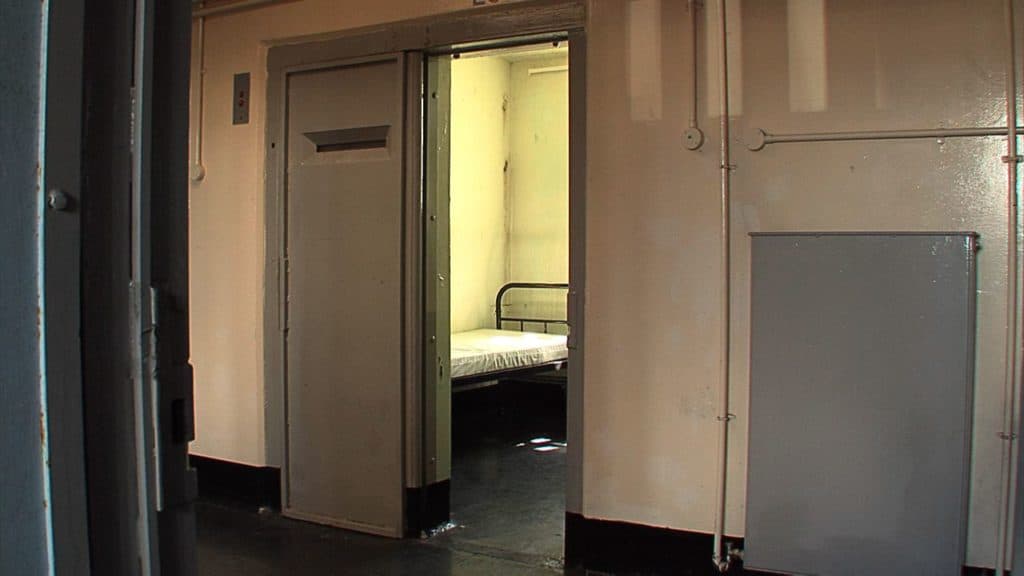
01
A cell viewed from a corridor of one of the H-Blocks.
A cell viewed from a corridor of one of the H-Blocks.
Context
Thirty years of the political violence in Northern Ireland/North of Ireland has led to a power-sharing arrangement that has not always found it easy to address the legacy of a conflicted past in a contested present. Official reports, such as the Haass-O’Sullivan report (2013), the Eames-Bradley report (2009) and the Bloomfield report (1998) all recommended storytelling as a way of engaging with the legacy of a past that is both politically and psychically sensitive. This recommendation was also carried through to the Stormont House Agreement (2014). However, given that none of these were implemented, a number of community and academic initiatives filled the vacuum, including Healing Through Remembering and Accounts of the Conflict. The Prisons Memory Archive (PMA) is one such project and focuses on the prisons, which were a touchstone and tinderbox throughout the conflict.
Making
The National Lottery Heritage Fund (at the time called the Heritage Lottery Fund) came on board as funders enabling filming inside Armagh Gaol in 2006 and the Maze and Long Kesh in 2007. They were impressed with our ethical approach – we applied protocols of co-ownership, where participants become co-authors of their own story, with the right to withdraw up to the point of exhibition; inclusivity to ensure a multi-narrative archive with prison staff, prisoners, visitors, teachers, chaplains, etc.; and life-story telling, where leading questions are eschewed in order to return more agency to the participants.
Thirty years of the political violence in Northern Ireland/North of Ireland has led to a power-sharing arrangement that has not always found it easy to address the legacy of a conflicted past in a contested present. Official reports, such as the Haass-O’Sullivan report (2013), the Eames-Bradley report (2009) and the Bloomfield report (1998) all recommended storytelling as a way of engaging with the legacy of a past that is both politically and psychically sensitive. This recommendation was also carried through to the Stormont House Agreement (2014). However, given that none of these were implemented, a number of community and academic initiatives filled the vacuum, including Healing Through Remembering and Accounts of the Conflict. The Prisons Memory Archive (PMA) is one such project and focuses on the prisons, which were a touchstone and tinderbox throughout the conflict.
Making
The National Lottery Heritage Fund (at the time called the Heritage Lottery Fund) came on board as funders enabling filming inside Armagh Gaol in 2006 and the Maze and Long Kesh in 2007. They were impressed with our ethical approach – we applied protocols of co-ownership, where participants become co-authors of their own story, with the right to withdraw up to the point of exhibition; inclusivity to ensure a multi-narrative archive with prison staff, prisoners, visitors, teachers, chaplains, etc.; and life-story telling, where leading questions are eschewed in order to return more agency to the participants.
“Most participants took the initiative in deciding where to go and what to talk about, as the materiality of the spaces stimulated their memories.”
We filmed 35 interviews inside Armagh Gaol over two weeks and 140 interviews over three weeks inside the Maze and Long Kesh. Each participant, or small group of participants, was briefed for about 15 minutes about the process of filming and 15 minutes after to ensure they were comfortable with what had been recorded. The recordings usually included one camera operator, using a radio microphone(s), accompanying the participant as they walked-and-talked their way about the prison site, with only occasional questions posed to tease out issues they had already expressed a wish to address.
Most participants took the initiative in deciding where to go and what to talk about, as the materiality of the spaces stimulated their memories. Many instinctively took on the role of co-directing: the choreography of camera operator and participant collaboration can clearly be observed when Armagh prisoner, Josie Dowds, walks ahead of the operator, who tilts the camera to have a temporary view of the first floor landing, then rushes down the stairs to catch up, and they circle each other looking for the best positions – the operator to position the light behind him and the participant to see into the cell – as Josie remembers raising a new-born baby in the prison. This sequence also shows evidence of the arrangement with the camera operators, who were asked not to consider the film being cut in an edit suite, but instead to imagine that the entire recording would be exhibited. So although the operator does rush down the stairs, he keeps the camera as steady as possible (we hear him breathing heavily and coughing).
Our methodology produced a free-flowing structure, with participants’ stories veering from chronological sequencing to more spatially influenced. A memory could be resuscitated by the sight, sound or smell of a discovery. In one example, a Prison Officer, John Hetherington, enters the hospital wing of the Maze and Long Kesh and pauses, before offering a consideration of his experiences during the period when ten prisoners died on hunger strike in 1981, culminating with the observation: “This is the most difficult place I have been to for many years.” For some participants the experience was expressed in wonder, as they were offered the opportunity to visit the site of their intense previous experiences. When Jackie Upton approaches her old cell, she appears shocked at its size: “My God, it’s small.” She leans on the landing railing, physically relaxed as she recounts her experiences, sometimes difficult, of being the only loyalist in a wing of republican prisoners.
Most participants took the initiative in deciding where to go and what to talk about, as the materiality of the spaces stimulated their memories. Many instinctively took on the role of co-directing: the choreography of camera operator and participant collaboration can clearly be observed when Armagh prisoner, Josie Dowds, walks ahead of the operator, who tilts the camera to have a temporary view of the first floor landing, then rushes down the stairs to catch up, and they circle each other looking for the best positions – the operator to position the light behind him and the participant to see into the cell – as Josie remembers raising a new-born baby in the prison. This sequence also shows evidence of the arrangement with the camera operators, who were asked not to consider the film being cut in an edit suite, but instead to imagine that the entire recording would be exhibited. So although the operator does rush down the stairs, he keeps the camera as steady as possible (we hear him breathing heavily and coughing).
Our methodology produced a free-flowing structure, with participants’ stories veering from chronological sequencing to more spatially influenced. A memory could be resuscitated by the sight, sound or smell of a discovery. In one example, a Prison Officer, John Hetherington, enters the hospital wing of the Maze and Long Kesh and pauses, before offering a consideration of his experiences during the period when ten prisoners died on hunger strike in 1981, culminating with the observation: “This is the most difficult place I have been to for many years.” For some participants the experience was expressed in wonder, as they were offered the opportunity to visit the site of their intense previous experiences. When Jackie Upton approaches her old cell, she appears shocked at its size: “My God, it’s small.” She leans on the landing railing, physically relaxed as she recounts her experiences, sometimes difficult, of being the only loyalist in a wing of republican prisoners.
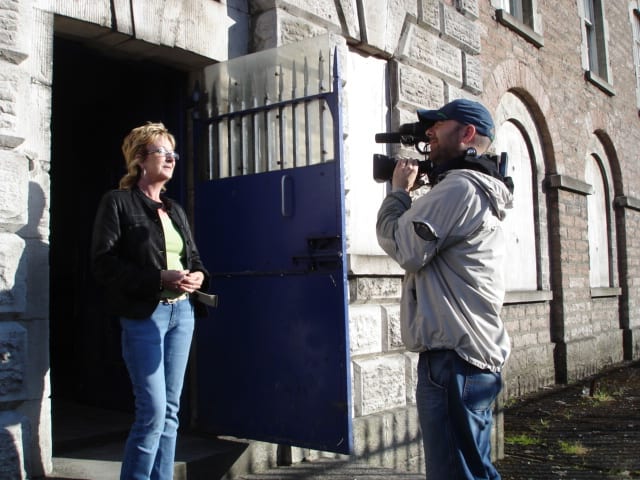
02
Marian Friel on-site at Armagh Gaol in 2006, being recorded by Mick Doyle.
Marian Friel on-site at Armagh Gaol in 2006, being recorded by Mick Doyle.
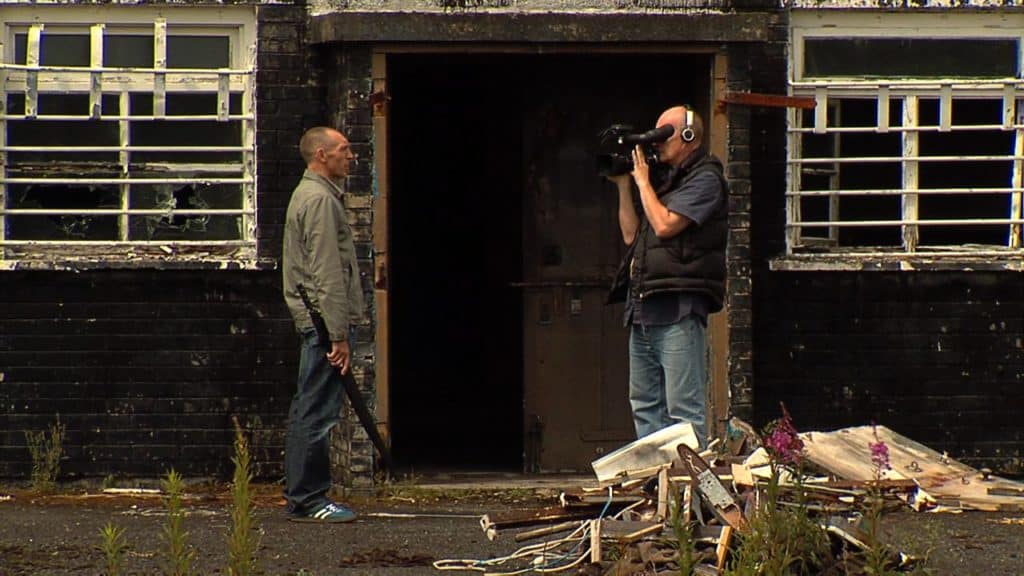
03
William Mitchell outside a Nissen hut in 2007, being recorded by Paddy Stevenson.
William Mitchell outside a Nissen hut in 2007, being recorded by Paddy Stevenson.
Exhibitions
Over the next ten years, we found it difficult to access funding for post-production of the recordings – almost 300 hours’ worth. One reason, we assume, was the ongoing political contestation over the legacy of the MLK site, with €18 million of European funding withdrawn when the plans for an International Conflict Resolution Centre were scrapped. (‘EU body withdraws Maze Prison peace centre money,’ BBC News, 4 October 2013) However, some funding from PhD scholarships and the Community Relations Council during that time allowed us to edit films and create the original PMA website, which launched in 2012. We also managed to host events at community centres, workshops, festivals, and conferences, both locally and internationally, including Armagh Market Place Theatre, Belfast Film Festival, and the University of Sao Paolo, to mention just a few.
Over the next ten years, we found it difficult to access funding for post-production of the recordings – almost 300 hours’ worth. One reason, we assume, was the ongoing political contestation over the legacy of the MLK site, with €18 million of European funding withdrawn when the plans for an International Conflict Resolution Centre were scrapped. (‘EU body withdraws Maze Prison peace centre money,’ BBC News, 4 October 2013) However, some funding from PhD scholarships and the Community Relations Council during that time allowed us to edit films and create the original PMA website, which launched in 2012. We also managed to host events at community centres, workshops, festivals, and conferences, both locally and internationally, including Armagh Market Place Theatre, Belfast Film Festival, and the University of Sao Paolo, to mention just a few.
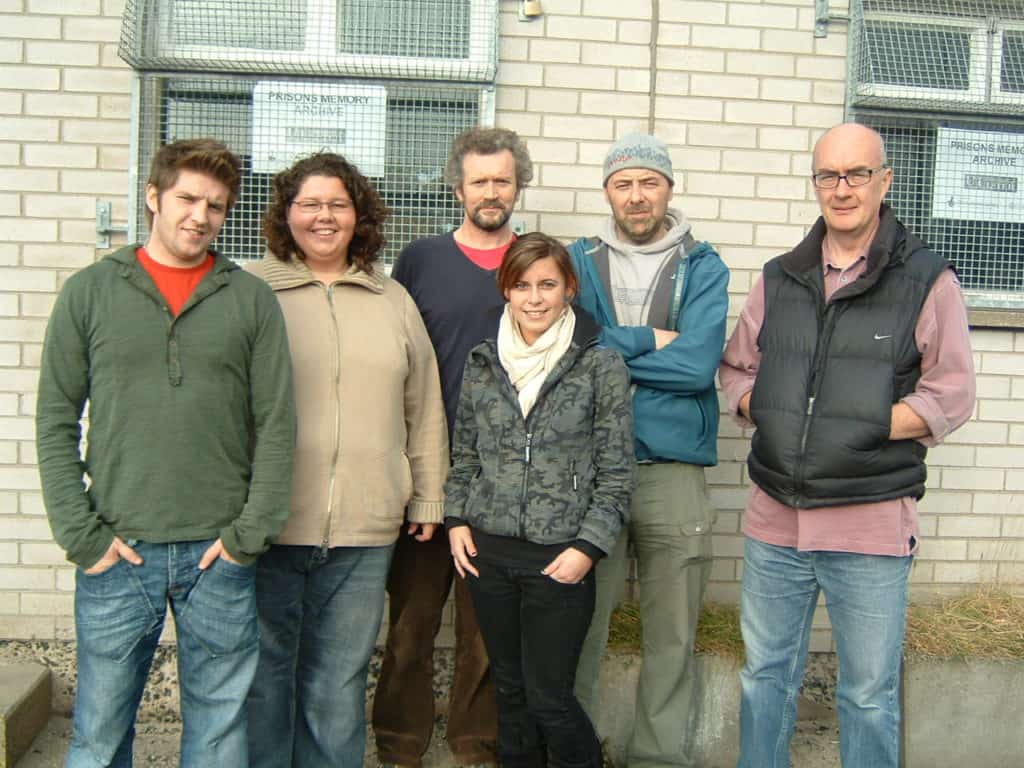
04
Some of the production crew standing outside the on-site production office in the H-Blocks. L-R: Greg McGuinness (Assistant), Lorraine Dennis (Project Manager), Cahal McLaughlin (Project Director), Andrea Kilpatrick (Assistant), Mick Doyle (Camera Operator), Paddy Stevenson (Camera Operator).
Some of the production crew standing outside the on-site production office in the H-Blocks. L-R: Greg McGuinness (Assistant), Lorraine Dennis (Project Manager), Cahal McLaughlin (Project Director), Andrea Kilpatrick (Assistant), Mick Doyle (Camera Operator), Paddy Stevenson (Camera Operator).
Co-ownership – risks and rewards
Co-ownership is a crucial principle for the PMA; in fact, it was the only way we could encourage some participants to record their stories. However, co-ownership does risk some participants withdrawing before their recording goes public. This occurred a few times. In the fallout of the Boston College Belfast Project, for example, when oral histories ended up as potential evidence in court cases, some ex-prisoners in our project asked for their material to be deleted. “Nothing personal,” they said, “we just don’t trust universities.” When Prison Officer David Black was shot dead in 2012, two prison officers withdrew their material. However, the rewards are that the majority of our other participants – ex-prisoners, prison officers and others – have remained with the PMA, citing its co-ownership principle as the deciding factor. A Management Group, consisting of individual and representative participant volunteers, applied the protocol of co-ownership to managing the archive, and took strategic decisions over the years. When it was agreed, for reasons of sustainability and legal status, to offer the ownership of the archive to QUB, this group became the Advisory Group.
Co-ownership is a crucial principle for the PMA; in fact, it was the only way we could encourage some participants to record their stories. However, co-ownership does risk some participants withdrawing before their recording goes public. This occurred a few times. In the fallout of the Boston College Belfast Project, for example, when oral histories ended up as potential evidence in court cases, some ex-prisoners in our project asked for their material to be deleted. “Nothing personal,” they said, “we just don’t trust universities.” When Prison Officer David Black was shot dead in 2012, two prison officers withdrew their material. However, the rewards are that the majority of our other participants – ex-prisoners, prison officers and others – have remained with the PMA, citing its co-ownership principle as the deciding factor. A Management Group, consisting of individual and representative participant volunteers, applied the protocol of co-ownership to managing the archive, and took strategic decisions over the years. When it was agreed, for reasons of sustainability and legal status, to offer the ownership of the archive to QUB, this group became the Advisory Group.
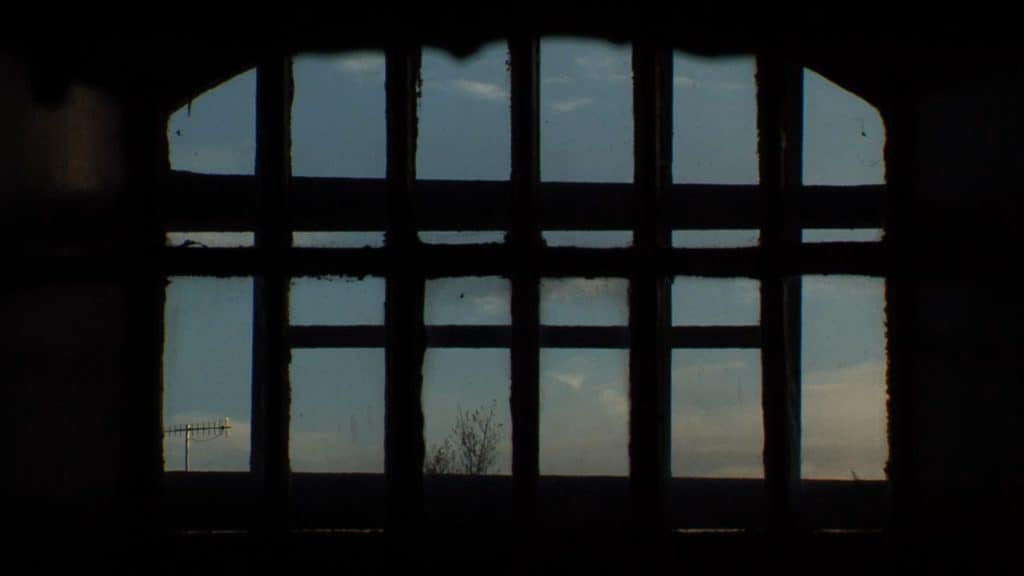
05
A cell window in D-Wing, Armagh Gaol.
A cell window in D-Wing, Armagh Gaol.
Crossing the Finishing Line
In 2016, a new page was turned for the PMA when the Public Record Office (PRONI) agreed to partner us in a new funding application to the National Lottery Heritage Fund. We were grateful to secure new support from the Heritage Fund, and after a Development Grant to establish feasibility was successful, an intense three-and-a-half years followed. During this time our project staff based at QUB have been preparing the archive for preservation, access and engagement at PRONI, developing the new PMA website and delivering outreach activities. Much credit must go to the creativity and endurance of the project team to manage, archive, edit, and organise activities, as well as plan this new website.
Conclusion
We hope our approach to managing the difficulties of addressing our violent past acknowledges aesthetic and ethical concerns of how to record and exhibit memories and is of use to others. If credit must go to the participants for their courage and trust in recounting their memories to us, then equal credit must go to our partners and funders, and, not least, to the project team for their dedication.
In 2016, a new page was turned for the PMA when the Public Record Office (PRONI) agreed to partner us in a new funding application to the National Lottery Heritage Fund. We were grateful to secure new support from the Heritage Fund, and after a Development Grant to establish feasibility was successful, an intense three-and-a-half years followed. During this time our project staff based at QUB have been preparing the archive for preservation, access and engagement at PRONI, developing the new PMA website and delivering outreach activities. Much credit must go to the creativity and endurance of the project team to manage, archive, edit, and organise activities, as well as plan this new website.
Conclusion
We hope our approach to managing the difficulties of addressing our violent past acknowledges aesthetic and ethical concerns of how to record and exhibit memories and is of use to others. If credit must go to the participants for their courage and trust in recounting their memories to us, then equal credit must go to our partners and funders, and, not least, to the project team for their dedication.
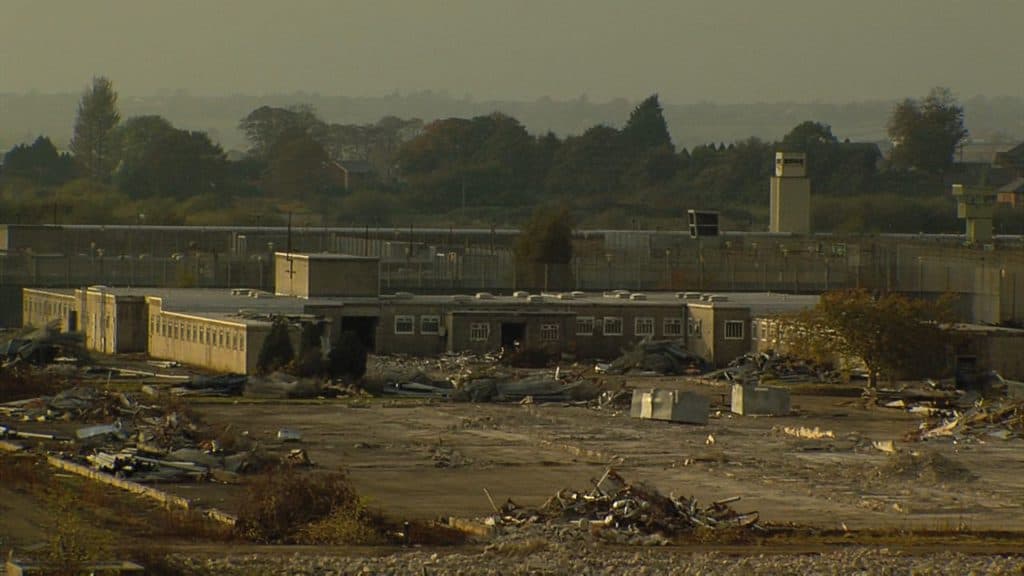
06
One of the H-Blocks, surrounded by the rubble of demolition works, viewed from a watchtower on the site of the Maze and Long Kesh in 2007.
One of the H-Blocks, surrounded by the rubble of demolition works, viewed from a watchtower on the site of the Maze and Long Kesh in 2007.




